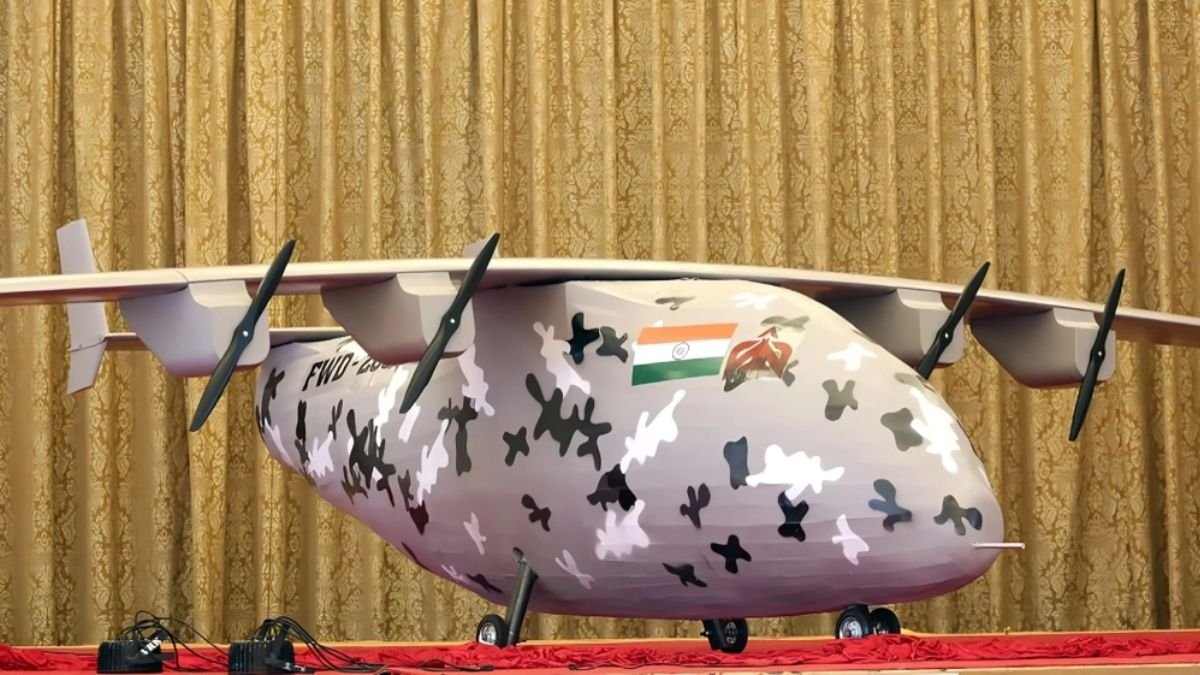Is India’s First Bomber UAV a Scam?

Recent media reports indicate that the FWD-200B bomber UAV developed by Flying Wedge Defence, an Indian defence and aerospace company has a payload capacity of 100 kg and falls under the category of a MALE Unmanned Combat Aerial Vehicle (medium-altitude,long-endurance).
According to the reports, The FWD-200B is equipped with optical surveillance payloads and incorporates missile like weapons for precise air strikes. It can reach a maximum takeoff weight of 498 kg
and includes a ground control station (GCS) with a range of 200 km. The drone boasts a top speed of 370 km/h and can endure flights lasting 12-20 hours. Surprisingly, the company’s website lacks information about this drone, focusing instead on standard quadcopters for various applications and conceptual military projects presented only as renderings. However, what truly stands out about the FWD200B is its distinctive shape.

In general, the design attributes of modern Medium Altitude Long Endurance (MALE) UAVs embody a blend of endurance, payload capacity, operational adaptability, and mission efficiency. Common characteristics among contemporary MALE drones include:
- Optimized wing design prioritizing endurance and efficient cruising.
- Airframe configurations aimed at minimizing drag and enhancing aerodynamic efficiency, thereby facilitating prolonged endurance. Some models are engineered to reduce the UAV’s Radar Cross Section (RCS).
- Compared to smaller tactical UAVs occasionally showcased by other Indian startups, MALE UAVs typically possess larger dimensions and greater weight, enabling them to carry heavier payloads and accommodate increased fuel for extended endurance.
- Integration of advanced communication systems for remote control and data transmission beyond line-of-sight. These systems empower operators to remotely manage the UAV while receiving real-time sensor data and imagery.
- Despite the abundance of distinctive designs within the MALE UAV realm, the FWD-200B stands out as particularly intriguing. It would be interesting to know how it will navigate and behave in the skies while maintaining its current shape and notably expansive wingspan.
- Additionally, the landing gear appears disproportionately small for the fuselage, while the engine details seem to be merely hinted at rather than explicitly depicted.
It appears plausible that the FWD-200B would require a fundamentally different wing design, possibly with a substantial wingspan, as well as a sturdier landing gear to ensure safe takeoff and landing. Nonetheless, there’s a remark circulating that, despite the domestic excitement, it’s not unprecedented for an Indian startup to unveil a UAV with bold claims that ultimately fail to materialize. Let’s wait and see until contractor discloses more information on this.
The company expressed that in coming days they would apply for certification from Centre for Military Airworthiness & Certification (CEMILAC) certification. Upon certification completion, we’ll be prepared to introduce it into our armed forces. Additionally, it is planned to market it to other nations, particularly in Africa and Southeast Asia. The company has announced a significant cost reduction milestone, with the domestically produced FWD-200B priced at just Rs 25 crores, a sharp contrast to the hefty Rs 250 crore price tag of imported US Predator drones.
In comparing the FWD-200B with the MQ-9, it’s important to note that they belong to different categories. The FWD-200B is a Medium Altitude Long Endurance (MALE) UAV, while the MQ-9 is a High-Altitude Long Endurance (HALE) drone equipped with advanced avionics, sensors, a powerful turboprop engine, and greater payload capacity, thus justifying its higher price. Let’s delve into the specifications below:

It’s possible that this could be merely a model that never took flight. The overall platform lacks aerodynamic qualities and is aesthetically unappealing. The propellers seem disproportionately small, raising doubts about their ability to generate the necessary thrust for propulsion.






Let’s wait and watch.